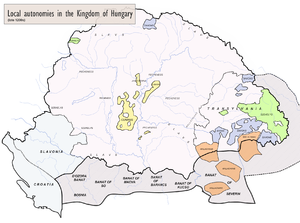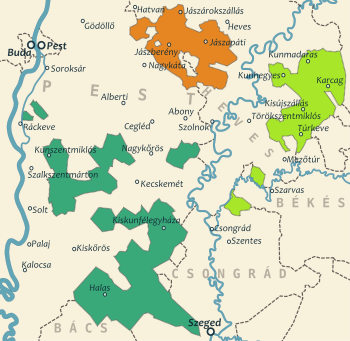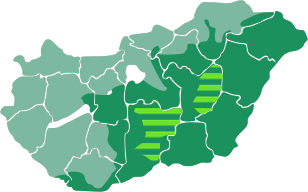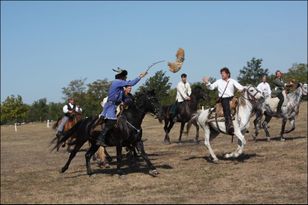كونساگ
| Kunság (Cumania) Jászkunság (Jazygia-Cumania) | |||||||||||
|---|---|---|---|---|---|---|---|---|---|---|---|
| كيان حكم ذاتي the مملكة المجر | |||||||||||
| 1279–1876 | |||||||||||
 المجر الأرپادية؛ بالأصفر، المناطق التي استوطنتها شعوب القومان و Jazyg، و Pecheneg | |||||||||||
| العاصمة | Kiskunfélegyháza (قومانيا الصغرى) Karcag (قومانيا الكبرى) | ||||||||||
| صفة المواطن | قومان/كون | ||||||||||
| المساحة | |||||||||||
• 1820s | 420 km2 (160 sq mi) | ||||||||||
| التعداد | |||||||||||
• 1855 | 120000 | ||||||||||
| التاريخ | |||||||||||
| التاريخ | |||||||||||
• منح الحكم الذاتي العرقي | 1279 | ||||||||||
• خلق المقار | 15th century | ||||||||||
| 1540s | |||||||||||
• بيعت إلى Teutonic Order | 1702 | ||||||||||
• أُخمِدت طبقاً لـTreaty of Szatmár | 1711 | ||||||||||
• Restored as Jászkunság | 1745 | ||||||||||
• Disestablished | 1876 | ||||||||||
| |||||||||||
| اليوم جزء من | |||||||||||
كونساگ (Kunság ؛ ألمانية: Kumanien؛ لاتينية: Cumania) هي منطقة تاريخية وعرقية وجغرافية في المجر، تناظر كيان سياسي سابق خلقه عرق القومان أو الكون. وهي حالياً منقسمة بين مقاطعتي باتش-كيشكون و ياس-ناتكون-سولنوك؛ اللتين تناظران تقريباً الكيانين التقليديين المتميزين، قومانيا الصغرى و قومانيا الكبرى، المفصولات طولياً بنهر تيسا. كونساگ وأقسامها نـُظـِّما لأول مرة ضمن مملكة المجر كمقر لشعب القومان شبه الرحال الهارب من من الامبراطورية المنغولية. جيوب القومان كانت تـُضم أحياناً مع يازيگيا، التي كانت منظمة بشكل مماثل ومسماة على اسم الرحل الأوسـِت.
كونساگ كانت نتيجة الاستعمار الثاني والنهائي للقومان في المجر؛ while not the only Cuman-inhabited area, it remained the only center of Cuman self-rule بعد نهاية المجر الأرپادية. Tradition dates its emergence to 1279, when Ladislaus IV, a half-Cuman King of Hungary, granted its first set of fiscal and judicial privileges. These were confirmed in the 15th century, when Cumans began organizing themselves into "seats" overseen by a Palatine of the Kingdom. However, the consolidation of feudalism created dissatisfaction across the region, leading to its participation in György Dózsa's uprising of 1514.
The area was devastated during the Ottoman–Hungarian wars, and further depopulated by the Ottoman occupation of Hungary. It was recolonized by Cumans, Hungarians and Slovaks upon the establishment of Habsburg Hungary. The new regime granted Kunság to the Teutonic Order and repressed Cuman separatism, especially after the inhabitants' willing participation in Rákóczi's War of Independence. Centralizing tendencies were nevertheless toned down under Maria Theresa and, in 1745, Kunság and Jazygia were merged into a single autonomous district, whose inhabitants were allowed to buy their way out of serfdom. The prosperous region had a population boom, which allowed its now-mixed population to colonize other parts of the realm.
Intellectual debates about the characteristics and role of Cuman identity first took place under Josephinism, and were prolonged over the following centuries—even as the Cuman language had died out. Initially, Kunság intellectuals described their identity as Finno-Ugric and complementing Hungarian nationalism. With this shift in discourse, Kunság and Jazygia ceased to exist politically in 1876, when they were folded into larger and less autonomous counties. Popular interest in the Cuman legacy endures into the 21st century, with more emphasis placed on the region's Turkic roots, as well as on differences between Cuman and non-Cuman Hungarians.
التاريخ
الأصول
الاستجماع
خلق ياشكونساگ
العرق والثقافة
الجينات
التقاليد
ملاحظات
المراجع
- Gábor Bagi,
- "Társadalmi és politikai küzdelmeka reformkori Jászkunságban", in Honismeret, Vol. 26, Issue 3, 1998, pp. 59–61.
- "Muszáj vármegye. A Jászkun kerület felszámolása", in Rubicon, Vol. 28, Issue 6, June 2017, pp. 76–80.
- Réka Balázs, Rozália Kustár, Mounds, Hills, Fortresses in the Danube-Tisza Interfluve. Kecskemét: Kiskunság National Park Directorate, 2015. ISBN 978-615-5598-02-9
- Erzsébet Bánki Molnár, "Soziale Lage und Tracht in Kleinkumanien im 18.–19. Jahrhundert", in Acta Ethnographica Hungarica, Vol. 45, Issues 1–2, 2000, pp. 37–46.
- Maria Berényi, "Colonii macedoromâne în Ungaria (secolul XVIII–XX)", in Maria Berényi (ed.), Simpozion. Comunicările celui de-al XI-lea simpozion al cercetătorilor români din Ungaria. Giula, 24–25 noiembrie 2001, pp. 66–87. Gyula: Research Institute of the Romanians in Hungary, 2001. ISBN 963-00-9597-1
- Judit Bukovszki, Csaba Tóth, "Changes in the State of Cumanian Mounds Lying in the Vicinity of Karcag from the End of the 18th Century till Today", in Acta Geographica Ac Geologica et Meteorologica Debrecina, Vol. 3, 2008, pp. 145–153.
- Erdal Çoban, "Eastern Muslim Groups among Hungarians in the Middle Ages", in Bilig. Türk Dünyası Sosyal Bilimler Dergisi, Issue 63, Autumn 2012, pp. 55–76.
- Ioan Crișan, "Considerații cu privire la colonizarea cumanilor în Bihorul medieval. Arheologie, onomastică, toponimie", in Revista Crisia, Vol. XLVI, 2016, pp. 13–24.
- György Elek, "Város a hátországban. Karcag 1848-49-ben", in Honismeret, Vol. 26, Issue 3, 1998, pp. 61–69.
- Veronika Gervers, The Influence of Ottoman Turkish Textiles and Costume in Eastern Europe, with Particular Reference to Hungary. History, Technology and Art, Monograph 4. Toronto: Royal Ontario Museum, 1982. ISBN 0-88854-258-5
- Gyula Gyenis, "Dermatoglyphics of Three Hungarian Populations", in American Journal of Physical Anthropology, Vol. 42, Issue 2, 1975, pp. 229–232.
- György Györffy, "István Györffy, a Pioneer of Hungarian Ethnography", in Hungarian Heritage, Vol. 1, Issues 1–2, Spring/Autumn 2000, pp. 19–28.
- Đura Hardi, "Cumans and Mongols in the Region of Srem in 1241–1242: a Discussion on the Extent of Devastation", in Истраживања, Vol. 27, 2016, pp. 84–105.
- Gábor Hatházi, Katalin Szende, "Ethnic Groups and Cultures in Medieval Hungary", in Zsolt Visy, László Bartosiewicz (eds.), Hungarian Archaeology at the Turn of the Millennium, pp. 388–397. Budapest: Ministry of National Cultural Heritage & Teleki László Foundation, 2003. ISBN 963-86291-8-5
- Krisztián Hegedűs, "Kunszentmárton egyesületi életének sajátosságai a dualizmus korában", in Történeti Muzeológiai Szemle: A Magyar Múzeumi Történész Társulat Évkönyve, Vol. 14, 2015, pp. 7–24.
- Józsa Hévizi, Autonomies in Hungary and Europe: A Comparative Study. Buffalo: Corvinus Society, 2005. OCLC 645821696
- Éva Kincses-Nagy, "A Disappeared People and a Disappeared Language: The Cumans and the Cuman Language in Hungary", in Tehlikedeki Diller Dergisi, Summer 2013, pp. 171–186.
- Johann Georg Kohl, "The Clangour of Musicians", in Hungarian Heritage, Vol. 9, Issues 1–2, 2008, pp. 48–53.
- Kyra Lyublyanovics, "The Cumans in Medieval Hungary and the Question of Ethnicity", in Annual of Medieval Studies at CEU, Vol. 17, 2011, pp. 153–169.
- Conrad Malte-Brun, Universal Geography, Or, a Description of All Parts of the World. Volume VI. Boston & New York City: Wells and Lilly & White, Gallaher and White, 1828.
- Henry Marczali, Hungary in the Eighteenth Century. Cambridge: Cambridge University Press, 1910.
- Andrea Emese Matkó, Csaba Berde, "Relationships between Competitiveness in the Northern Great Plain and the Organisational Culture of Local Authorities", in APSTRACT: Applied Studies in Agribusiness and Commerce, Vol. 06, Issue 5, 2013, pp. 13–21.
- Silviu Oța, The Mortuary Archaeology of the Medieval Banat (10th–14th Centuries). Leiden & Boston: Brill Publishers, 2015. ISBN 978-90-04-21438-5
- Victor Spinei, "Episcopia cumanilor. Coordonate evolutive", in Arheologia Moldovei, Vol. XXX, 2007, pp. 137–181.
- Former country articles requiring maintenance
- Articles containing ألمانية-language text
- Pages using Lang-xx templates
- Articles containing لاتينية-language text
- Pages using multiple image with auto scaled images
- Pages using multiple image with manual scaled images
- Hungary articles missing geocoordinate data
- All articles needing coordinates
- قومان
- الشتات الأوستي
- Ethnic enclaves in Hungary
- مناطق تاريخية في المجر
- السهل المجري الكبير
- جغرافيا مقاطعة باتش-كيشكون
- جغرافيا مقاطعة ياس-ناتكون-سولنوك
- الفرسان التيوتون







